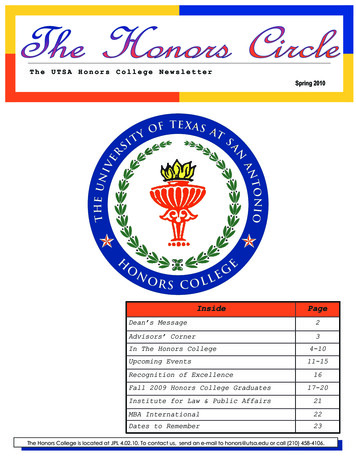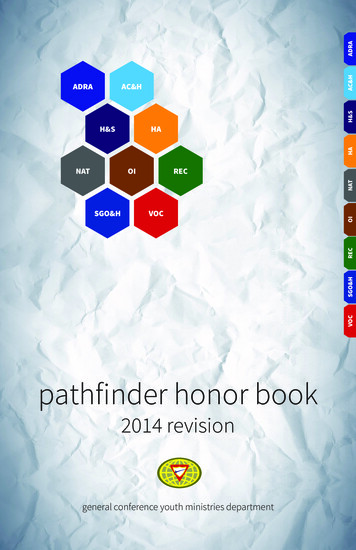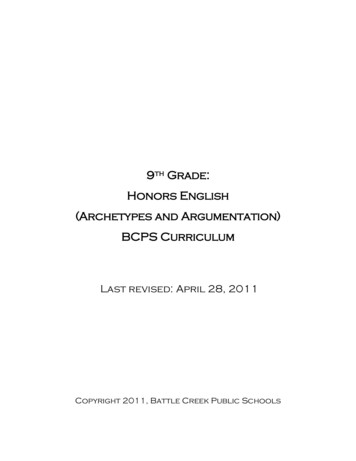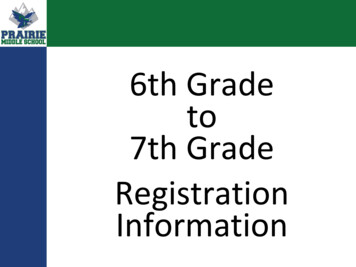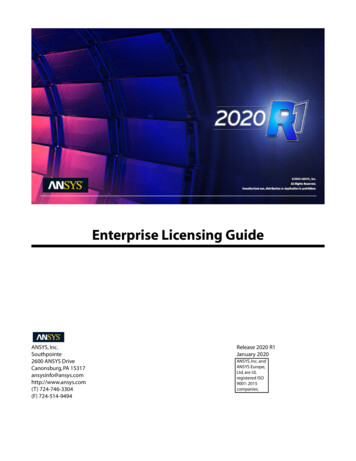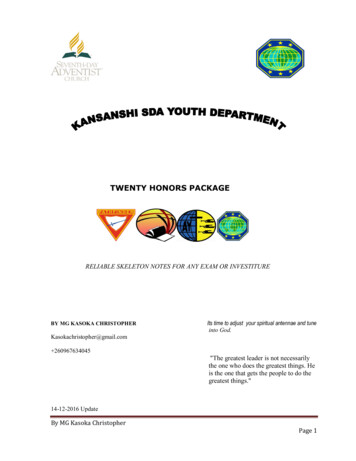
Transcription
TWENTY HONORS PACKAGERELIABLE SKELETON NOTES FOR ANY EXAM OR INVESTITUREBY MG KASOKA CHRISTOPHERIts time to adjust your spiritual antennae and tuneinto God.Kasokachristopher@gmail.com 260967634045"The greatest leader is not necessarilythe one who does the greatest things. Heis the one that gets the people to do thegreatest things."14-12-2016 UpdateBy MG Kasoka ChristopherPage 1
18.19.20.HONOURPAGE NUMBERChristian Story Telling . 3Chairmanship .5First Aid .7Knot Tying .11Camp Craft .13Cats of the World .17Laundry .19Christian Entertainment .21Stars 23Homiletics / Preaching .30Mammals .31Drilling and Marching 33Home Nursing 34Poultry 35Dogs of the World .37Cookery .39Cycling .40Environmental Conservation .41House Keeping .41Ecology .44Special Thanks to MG David Akombwa for the great help he rendered, MG Tembo Patrick and MG AlvinHimbayi for verification of this copy and everyone else who helped directly or indirectly. Not forgettingmum, dad and my siblings for the family and financial support. Above all glory and honor to God for grantingme this opportunity to attend to the need of some youths in need of this booklet.Images: MG Christopher Laurencio KasokaBy MG Kasoka ChristopherPage 2
1. CHRISTIAN STORY TELLING (outreach)In this honor we mainly deal with two things stories and parables. A story is a talk given about somebody’sexperience, which needs time, date, place and title. However a parable does not need time, date, place andtitle. This simply means the difference between a story and a parable is that a story needs time, date, placeand title while the parable doesn’t.For a story to be presented a storyteller is needed. A storyteller is a person who narrates stories or parables.Characteristics of a Storyteller1. He must be active of the listeners.He / She should present stories actively with vigor and gestures to attract the attention2. He must be creative-He / She must be creative in narrating his story or parable this makes listeners discovernew things.3. He must be resourceful -He / She must be able to produce resources i.e. pictures, diagrams, etc to make thelisteners understand the story.4. He must enjoy telling stories - A storyteller has to have interest in telling stories.5. Ensure eye contact-The teller must observe eye contact this will help to know the effect of his story.6. Must be of good characteractual story.Telling good stories with your life and unfolds to the time of telling the7. Must be neatly dressed -From your character a good story continues with how neat you are, neatnessattracts people s attention.8. Must be fluent in speechspeech gives the teller confidence.-Disturbed speech derails the listener’s attention. Fluent inParts of a story1. Title or theme- This is part that’s introduces the story.2. Introduction - This is the part that presents the challenges of the story.3. Main body- This is the part that develops the story giving the facts that make it up.4. Climax- This is the part that has the main point of the story and is emphasized.5. Conclusion- This is the part that presents the solutions of the story and the appeal.Essentials of Story Tellinga) Before telling a story a storyteller should do the following:a. Select your story- Keep in mind the number and type of people in the audience and the occasion.b. Know the storythe story.- No matter how experienced one is as a storyteller, you need to acquaint your self toc. Feel the story- One should be able to see the scenes in imagination.d. Modify your story- A story must suit the audience you are telling it to.By MG Kasoka ChristopherPage 3
e. Analyze and outline your story- Must be able to tell the story stage by stage.Purposes of Stories To educate- A true story is based on what happened this should educate the listeners. To Entertain and inform - Some stories are there to amuse the listeners and to inform them of certainacts of life.Sources of Christian Stories BibleLife ExperienceNatureSacred HistoryBooks (Magazines News Papers etc)Types of Stories1. Myth - Mythology, the body of myths of a particular culture, and the study andinterpretation of such myths. A myth may be broadly defined as a narrative that throughmany retellings has become an accepted tradition in a society. By this definition, the termmythology might include all traditional tales, from the creation stories of ancient Egypt to thesagas of Icelandic literature to the American folktale of Paul Bunyan.2. Fairly tales - Story for children with imaginary characters or magical people. The popularfairy tale about Cinderella portrays a girl who suffers the wrath of her stepmother andstepsisters. Cinderella is visited by her fairy godmother, who outfits her and gives her horsesand a coach so she can go to a masked ball. At the dance Cinderella meets the prince, but sheleaves before he learns her name. The prince is so taken with Cinderella that he travels thecountryside until he finds her.3. Fable - Fable, short literary composition in prose or verse, conveying a universal cautionaryor moral truth. The moral is usually summed up at the end of the story, which generally tellsof conflict among animals that are given the attributes of human beings. The fable differsfrom the parable, also a short narrative designed to convey a moral truth, in that the fable isconcerned with the impossible and improbable, whereas the parable always deals withpossible events. Both fables and parables are forms of allegory. Fiction stories often-usinganimals as characters4. Legend - A legend is set in a specific place at a specific time; the subject is often a heroichistorical personage. A legend differs from a myth by portraying a human hero rather thanone who is a god. Legends, originally oral, have been developed into literary masterpieces.Among the most famous legends of all time are the classic epics the Iliad and the Odyssey ofancient Greece and the Aeneid of ancient Rome. From the Middle Ages come legends aboutArthur, king of the Britons; Charlemagne; and the German alchemist Faust5. Allegory- Allegory, fictional literary narrative or artistic expression that conveys a symbolicmeaning parallel to but distinct from, and more important than, the literal meaning. Allegoryhas also been defined as an extended metaphor (see Figure of Speech). The symbolicmeaning is usually expressed through personifications and other symbols. Related forms arethe fable and the parable, which are didactic, comparatively short and simple allegories.Note: This honor is a requirement for master guide investitureBy MG Kasoka ChristopherPage 4
2 CHAIRMANSHIP (Missionary Endeavour)Chairmanship is the art of leading out in decision-making. This is the art of presiding over a meeting. Aperson who chairs a meeting is called the chairman or chair person in instance were it is a lady. This chairmanis usually assisted by the secretary whose duty is to record and keep minutes of the meeting.Qualities of a Christian Chairman1.2.3.4.5.6.7.8.Must be spiritual Gen 6:9 He / She must walk with God.Must be a man of VisionMust know his tools and area of deliberations.Must have the love for God, love for people and the Church.Must be humble not pompous boastful and arrogant.Must be patientMust not fear confrontations must be a man of courage.Must be honest in all things a man of integrity.What every Chairman ought to Knowa.b.c.d.e.Know his destination (John 14:6)Must allow one subject at a time.Must ensure full and free debate.Must know that every member has equal rights to the others.Must ensure that the will of the majority is carried out and the will of the minority preserved.Ladder of Proceedings1. Recognize the Chair - A desiring member to speak must recognize or seek attention from the chair bylifting up his/her hand.2. Address the presiding officer- The member must address the chairman by mentioning the title of thepresiding officer, e.g. Mr. Chairman, Mr. President etc.3. Present the motion - The person on the floor must introduce the motion by saying “ I move that or Ipropose that ”4. Seconding the motion - This is when the chairperson asks for anyone agreeing with the motion in order orit to be discussed. A seconder of a motion has a right to change his mind and vote other wise.5. State the motion - The chairman here clarifies the motion to the house.6. Discuss- This is the stage were member’s air their views on the proposed motion.7. Vote - At this stage every member is supposed to side for either of the motions by raising hands,acclamation, secret ballot or any other acceptable means of voting.By MG Kasoka ChristopherPage 5
Recognize the ChairAddress the Presiding OfficerPresent the MotionSecond the MotionState the MotionDiscuss the MotionVoteGuidelines of Whom to Speak Preference must be given to the proposer of the motionA member who has not spoken has prior claim over one who has already discussed.A member who raises his hand first.Alternate between those for and against.Order of BusinessA list of items to be discussed in a meeting must be presented and adopted immediately after the devotion andprayer. This list of items is called an agenda.Below is a skeleton of an A.Y Executive agenda-:1.2.3.4.5.6.7.8.9.10.11.12.13.Call the meeting to orderOpening song and prayerDevotionSeason of PrayersRoll CallAdoption of AgendaApproval of Previous minutesMatters ArisingReportsNew Business e.g. Camp outAnnouncementsAdjournmentClosing PrayerBy MG Kasoka ChristopherPage 6
Chairmanship Language1.2.3.4.5.6.7.8.9.Call to orderCalling questionQuorumSecondingTable the motionmotionAdjournGavelMajorityDilatory motion– Attracting the attention of the house in order to begin business.– Tell the chair to put a motion to a vote– A minimum number required to make committee resolution legal.– Conquering with the thought or idea of the proposed motion– This is suspending discussion due to insufficient information on the– To end the meeting or break for a later time.– This is a small wooden hammer used to call a meeting to order.– When more people side for the motion at voting.– Useless or meaningless motion.Types of MotionsA motion is a piece of information or statement brought to the house, seconded discussed and voted to bemade legal. In this booklet we will look at 5 motions which are-:1. Main motion2. Subsidiary motionUnder discussions3. Privileged motionmotion to adjourn.4. Amendment5. Amendment to amendment- Original motion raised by a member.- Motion raised from the main motion e.g. motion to table the matter.- Motion, which does not need debate, second mend or voting e.g.- This is a change to an already existing motion.- This is a change to an already amended motionTypes of Committees1. Subcommittee – This is a short-term committee chosen to fulfill a specific goal. This committee ismade from the main committee, it is sometimes called an ad hock committee e.g. NominatingCommittee2. Standing committee – It is a permanent committee with a long span e.g. Constitution Committee.Note: This honor is a requirement for master guide investiture.3. FIRST AID (Health and Science)This is the first help given to a casualty (Injured or sick person) before being taken to a health institution.AimThe aim of first aid is to preserve life, promote quick recovery and to prevent injury from worsening.By MG Kasoka ChristopherPage 7
What a first aider ought to know1. A first aid has to know what to do. This is very cardinal because a helper who doesn’t know what todo may worsen the condition of the casualty. This is the reason why advanced aiders like doctors takethe longest period in University learning what to do.2. A first aider has to know that the life of the casualty lies in his or her own hands.3. A first aider has to know that the casualty entirely depends on him or her.4. A first aider has to know the principals of time in sickness and injuries. Time matters.Alphabet of First AidThe advice given on how a first aider ought to conduct him / herself is outlined as in what is sub headedThis alphabet is as follows: A- Always, B-Be, C-Calm, D-During, E – EmergenciesThis alphabet reads, as “Always be calm during emergencies”This is only to emphasis the importance of calmness when giving aidHowever this alphabet has also been interpreted asA- Air, B-Breath, C – CirculationThis simply means that a casualty needs enough air, an aider has to ensure that the casually is breathing and isconscious.Guidelines on Handling CasualtiesIn this sub heading we are going to look at brief guidelines that we ought to follow when handling casualtieswith certain elements. The first casualty we will handle is a person under -:ShockThis is a state were blood circulating to the brain is reduced it is also called circulatory collapse. This ismainly caused by major injuries that involve a vein or an artery. There are two types of shocks namelyestablished and nerve shock.Signs Of ShockSkin will be cold, feeble burns spotted and rapid shallow breathing and finally unconsciousnessTreatmentLie the casualty down, keep him/her warm, loosen all tight clothing reassure the casualty and if breathing isdifficult put the casualty in recovery position.BLEEDINGThere are two types of bleeding external and internal bleeding. External is where an artery or vein is injuredthe flow of blood is visible (seen) while in internal the blood flows under the skin. Under this sub head wewill look at the following types of bleeding-:By MG Kasoka ChristopherPage 8
NOSE BLEED-: This is the loss of blood from the nose. This is mainly caused by headache, foreignbody in the nose, fainting, and temporal shock, standing in the Sun etc.Signs -: Moderate flow of blood from cerebral spinal fluids (CSF)Treatment-: Sit the casualty down loosen tight clothing around the neck, let him breath through themouth, pinch the soft part of the nose, twist the head slightly backwards, release pressure after 10 to 15minutes. If bleeding continues repeat the steps. If bleeding has stopped clean the nose with a soaked clothe inluke warm water.FAINTING: This is a state of loosing consciousness. This is usually caused by fear, exhaustion, bad smell,severe bleeding etc.Signs-: The casualty will lose attention briefly and consciousness. They will usually fall down ifthey are in standing position.Treatment-: Lean the casualty between the knees, loosen all tight clothing, supply fresh air by clearingcrowd and flapping, check the breathing rate and if you doubt the condition seek medical aid.SNAKEBITE -: This is when a snake bites a person. The fallowing are the steps you need to take-:1. Consider your own safety – Make sure that the snake is not anywhere near cause it would be of harmto you.2. Lie the casualty down lowering the bitten area.3. Tie about 6 inches above the bitten area using a square note.4. Prick around the bitten area using a razor or a sterile needle.5. Apply, charcoal powder or suck the bitten area (with the era of HIV/AIDS it is advised to applycharcoal powder and apply to 6)6. Rush for medical aid.ChockChock is a foreign body in the wind pipe.SignsThe casualty will have popped out eyes, difficult in breathing and in a state of uncomfortability.TreatmentBend the casualty slightly over; hit the casualty moderately at the center of the back with the heel of yourpalm. If the foreign body is no dislodged hit a little harder. In children it has been advised that since theycannot be hit at the center of the back they can be held upside down and gently shake them.Note: Chock is dangerous and needs not be ignored. So if chock persists rush for medical aid.WOUNDSThere are two types of wounds closed and open wounds.By MG Kasoka ChristopherPage 9
Examples of Open Wound1. Abrasion– This is a scratching which can easily be infected2. Laceration– This is a wound made by instruments e.g. barbed wire.3. Incised – This is caused by a cut by very sharp instruments.Examples of Closed Wound1. Puncher – Caused by penetrating instruments e.g. nails and sprinters2. Avulsion – This is separation of TissuesTreatmentIn wounds a bandage can be used to prevent bleeding. Apply the bandage when the casualty is seated. Do nottie the bandage too tight. Use a reef knot or granny knot to tie. In A.Y emergencies bandages include scarves,belt, neckties soaks etc. However in major wounds rush to hospital for suturing before the wound is infected.Fracture.This is the breaking or cracking of the bone. There are two types of fractures namely:a. Simple compound– Breaking of the bone that can be seen and a wound is caused.b. Simple closed– Breaking of the bone under the skin and flesh.After presenting the basics of first aid the lesson is not complete without mentioning the tools that a first aiderhas to carry in a first aid kit.1.2.3.4.5.6.7.8.9.10.ScissorsBandageEye WashMethylated SpiritRazor BladeCotton WoolAntisepticPain KillerCharcoal PowderToken (Public Phone) Communication purposesNote: 1 : You may be examined on asthmatic attack, road traffic accident, drowning dog and insect bites. Soplease research.Note: 2: This honor is a master guide investiture requirementEquipmentBy MG Kasoka ChristopherCotton swabsEye cup or small plastic cupInstant-acting chemical cold packsPaper cupsPage 10
DressingsAdhesive bandage stripsButterfly bandagesElastic bandage, 3 inches wideHypoallergenic adhesive tapeRoller bandagesSterile cotton ballsSterile eye patchesSterile gauze pads, 4 by 4 inchesSterile nonstick padsTriangular bandageInstrumentsBlunt-tipped scissorsTweezersBulb syringe4. KNOT TYING (Recreation)By MG Kasoka ChristopherPage 11
Bow KnotKnots and Ropes work, is art of joining together pieces of such flexible material as rope, and of forming loopsor designs in ropes, string, or fibers. It is one of the oldest human skills, and serves both utilitarian anddecorative purposes; in some instances knotting has had magical or religious significance.The art of knotting and working with rope predates recorded history. It is a vital part of many trades and craftsand is particularly essential to sailors. The sailors who worked the large square-rigged cargo ships in the 19thcentury knew and used hundreds of knots and probably were the most accomplished practitioners of the craft.The total number of knots, bends, and hitches known amount to several thousand, many of them exceedinglycomplicated, and each designed for a single specific purpose.In knot tying a rope has two parts namely standing part and the doing or working part.A. Standing PartThis is the longer part of the knot.B. Working Part.This is the shorter part of the knot, which is usually active in making fastenings.Knots and their usesAs we look this subheading you will be made to believe that most knots are actually used in our day to dayactivities, these rage from tying our shoe laces, neck ties etc. The only problem however is we do not knowwhat these knots are called.Basically it is a requirement that each Youth must be able to tie at least 13 knots.Bight –This usually called the beginning knot. This knot is usually used to start and end any knot. In thisknot the working part is simply laid over the standing part and can be continued to be any knot.1. An over hand knot– This is also called the developing knot. This builds or continues mostknots. You will realize there are that for you to develop a knot you will to make an over hand knot.This knot provides a simple fastening, which is very easy to untie and usually unfastens on it’s on.2. Surgeons Knot – A surgeon is a medical personal who is specialized in surgery. This knot is used tostitch or suture fresh wounds (see first aid notes on wounds)3. Square Knot - This knot is a simple knot, which we practice through out our day-to-day activities.It is used to tie parcels and to create fastenings for bandages in first aid (See first aid notes onwounds)4. Granny Knot – This knot is slightly similar to the square knot the difference is minimal but cardinalas you will observe during the practical series of this honour. This knot is used to tie bandages andfire wood together in Camps.By MG Kasoka ChristopherPage 12
5. Slip Knot – This is simply a knot that slips. It creates a fasting and very easy to unfasten. This knot isusually used to fasten animals and for neckties.6. Double bow– This is a knot that you knew at a very tender age. This knot involves 2 strip knots tocreate a fastening. This knot is used to tie shoelaces.7. Bowline – This is a life-serving knot used to tie around a person and pull them from a ditch or a cave.This knot is usually tied in the waist of the victim this knot is recommended because it creates afastening, which does not tighten with pressure.8. Sheet bend – This Knot is used to join two ropes together of different thickness.9. Fisherman’s Knot– As the name en tells it is mostly used by fisherman to shorten and make strongertheir ropes as they pull out their catch. I want to think that when Christ instructed them to throw therenets once more and when they had that big catch they had to make their ropes short and stronger.10. Timber Hitch – Used to pull logs or timber. These are usually large ones. This knot is a very strongfastening.11. Clove Hitch – Used to start and end lashings12. Josephine’s Knot – Used to join to ropes of same thickness.Importance of Knot TyingThe importance of knot tying in our study is to tie fastens in pitching tents in camps. This continues tohandling injuries in first aid. It is also to use in our day-to-day activities, tying shoelace, neckties, parcels etc.Note 1 : Most of the practical work in this pamphlet must be handled by a knot tying professional. If nopractical is offered, the series will not be considered completeNote 2 : This honour is a master guide requirement honour.5. CAMP CRAFT (Recreation)Camping is an activity in which people live temporarily in the outdoors. History is filled withexamples of soldiers camping out, as at Valley Forge during the American Revolution (1775-1783),and of nomadic peoples throughout the world who move their campsites from place to place. Buttoday camping is primarily a recreational activity.By MG Kasoka ChristopherPage 13
Camping provides an opportunity to experience nature first and Campers participate in fishing,hunting, swimming, plant study, bird and wildlife watching, and nature photography. Just asimportantly, camping helps people escape the stress of city life. It provides physical benefits when itinvolves hiking to, from, and around a campsite, and many outdoor enthusiasts believe that campinginstills confidence in youngsters and offers older campers opportunities to challenge themselves inunfamiliar surroundings. Recent improvements in camping gear and a growing number oforganizations that teach people wilderness safety have made it easier to spend several days outdoor.Camp Craft is the art of camping. It is an Honour taken by the A.Y teaching them basic requirementsfor any camp. Camp craft is an adventure, which is taken in the wilderness;Reasons for Camping1.2.3.4.For spiritual GrowthDeveloping love among young ChristiansOvercoming unreasonable fearsTeaching people to live in harmony with NatureGenesis of CampingCamping started around 1850 and the first people to camp were hunters and fisherman and explorers in 1902camping stated in England and 1907 scouts started camping in AmericaTypes of Camping1. Hiking and Picnic2. Canoe Trip3. Comporee4. Camp Meeting5. Retreat Camp (Weekend Camp)6. Wilderness Camping (Survival)Rules for choosing a campsite1.2.3.4.5.6.7.8.Chose a well drained level groundChose a dry areaPick a warm areaPick a camping area with plenty of safe drinking waterWere there is enough dry woodNever camp under over lying cliffsStay away from mosquito infected areaHard rocks, dusty areas make a poor campsiteTypes of tentsThere are three types of tents cone, pyramid and prism.By MG Kasoka ChristopherPage 14
Camp equipments1. Kitchen gear - Plates, spoons, folks, cooking sticks, knives2. Toilet gear- Toilet paper, soap, toothpaste, toothbrush, towel3. Clothing gear- Jackets, sweaters, Raincoats etc4. Miscellaneous gear - Campus, candles, first Aid, Signal Mirror5. Sleeping gear - Blankets, bed sheets, pillows, mosquito netsGroup EquipmentShelterTent with poles, rainfly, and ground cloth; tent repair kitKitchenStove gear: stove; windscreen; fuel containers; matches or lighter; stove repair kitCook gear: pots; pot gripper; pot scrubber; cooking utensilsMiscellaneous GearFirst Aid kitCompassSewing kitPersonal EquipmentClothingInsulating layers: polypropylene long underwear; sweaters; fleece jacket and pantsDown vest or jacketWind and rain gear: jacket and pantsFootwear: Hiking boots; camp shoes; insulating socksGlovesStocking hat; sun hat; bandanaSwimming suitSleeping GearSleeping bagFoam pad: inflatable or closed-cellMiscellaneous GearBackpackFlashlight and extra batteriesSunglassesPersonal hygiene: toothbrush; toilet paper; sunblock; lip balmBy MG Kasoka ChristopherPage 15
Personal items: Camera and film; books; journal; fishing gearSleeping Facilities1.2.3.4.Sleeping BagLog pole bedHammockCamp bedSome Knots used in Camps1.2.3.4.5.6.7.8.Square knotSlip KnotClove HitchBowlineFisherman KnotTimber HitchSheep shankFigure EightContents of first Aid box.1. Scissors6. Cotton Wool11. Safe Pins2. Bandage3. Eye Wash7. Antiseptic 8. Medicines12. Calcium lotion4. Menthylated Spirit9. Charcoal Powder5. Razor Blade10. GlovesRequirements for starting a fire1. Fuel e.g wood2. Oxygen3. HeatTypes of Fires1. Pyramid fire - Used for light2. Cris Cross- Camp fire and Warming3. Hunters Fire - Used for cooking and roastingCamp Structures1.2.3.4.5.Toilets place them southwestKitchen NorthwestSleeping Quarters also NorthwestChapel center of campFire place far westCamp Officers1. Camp Master2. Camp Secretary4. Game MasterBy MG Kasoka ChristopherPage 16
4. Time Keeper5. Chorister6. Commanders8. Security Officers9. Prayer Band10. Kitchen Attendant11. Sanitation attendant6. CATS OF THE WORLD (Nature)The scientific name for cats is called FILIDAEPhysical Characteristics1.2.3.4.5.6.Four footed animalsThey have 18 toesThey have 30 teethThey have fur on their bodiesThey have no collar boneThey have nocturnal eyes because they absorb light during the day and use it during the night.Behaviour Characteristics1.2.3.4.5.6.7.8.The feed on row meatYoung ones are fed on milkThey produce less sound when movingThey are warm-bloodedThey play with their prey before eating itThey attack from the behindThey like sleeping during the dayThey are clean animals.Uses of cats or Benefits1.2.3.4.They keep balance of nature between carnivores and herbivores.Used as clocks in chinaUsed in medical reasonsFriends to man.Main food of the cats familyCats eat almost every kind of food that man eats e.g. beef, liver, heart and kidneys, cats also enjoy horse meatand fish – they have cutting teeth in the front of the mouth which are the smallest – cats use larger premolarsand molars in the back of the mouth for grinding and tearing food. They have long, sharp, eyesight.The use of cat’s whiskers They have 25-30 whiskers that grow in four rolls from the side of the mouth.They help the cats fell their way through bushes and avoid bumping into walls and trees. Cats do not use theirwhiskers to measure the space through which they walk as some people believe.By MG Kasoka ChristopherPage 17
Cats EyesCats absorbs light during the day and reflects it in the nightLegs of a catCats have five toes on their front foot and four on their back foot. Each toe has a sharp hook, cats ears areprotected. The outer part is protected by the ability to move. The ear is able to lay back against the head of thecat.Domesticated cats1. Royal Siamese2. Siamese3. Burmese4. ManxUndomesticated catsSiberian Tiger – Largest cat found in Asia only . Tiger- Has striped coat its body is biggerthan that of a leopard or a cheetah and is found in Asia.Lion - Biggest cat in Africa Known as the King of Jungle and is very dangerous and is found inAfrica .Leopard – is spotted like a cheetah. The body is bigger than of cheetah but smaller than that of atiger. It’s the most Deadly cat in Africa.Cheetah- It is the fastest running cat. It has a broad tail for balance. It has tear marks and it iscalled the crying cat. It travels at 10 miles per hour (About 105km / Hour) it is found in central Africaand Asia.Black Panther - It is the only cat, which is black.Jaguar - The largest cat in North America.Lynx- A cat with twisted ears. It is the smallest and dangerous ( The most powerful cat ofAfrica).Ocelot - It is found in Paraguay.Mountain Lion - It is the largest cat in America, it is known by several names “ Puma,Painter,Cougar and Catamount”By MG Kasoka ChristopherPage 18
Relate four stories in the Bible in which the cat family is mentioned4.5.6.7.The story of Samson (Judges 14:5-9The story of DavidDaniel in the Lions DenOne of the four beasts f Daniel Chapter 7 (Seven)7. LAUNDRY (Household Arts)This is an honor in which we learn how to wash and finish clothesReasons1. To prevent dirty2. To prevent skin disease and lice3. To Look presentableMethods of removing Dirtyi.ii.iii.By handBy MachineDry cleaning using a brush / Face clothItems NeededLinePegIronIroning sheetIron BoardIroning Blanket: Is a smooth wire or a rope for hanging clothes in the air: For fastening the clothes: Is used for ironing the clothes so that they look neat: It is used for covering the blanket on the iron board: This instrument is used for ironing clothes
2. Fairly tales - Story for children with imaginary characters or magical people. The popular fairy tale about Cinderella portrays a girl who suffers the wrath of her stepmother and stepsisters. Cinderella is visited by her fairy godmother, who outfits her and gives her horses and a coach so she can go to a masked ball.



